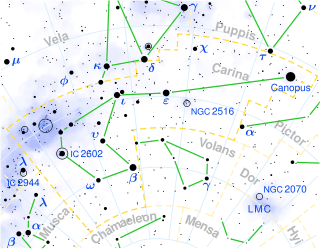Beta Carinae

| |
| Observation data Epoch J2000 Equinox J2000 | |
|---|---|
| Constellation | Carina |
| Right ascension | 09h 13m 11.97746s[1] |
| Declination | −69° 43′ 01.9473″[1] |
| Apparent magnitude (V) | 1.69[2] |
| Characteristics | |
| Spectral type | A1III[3] |
| U−B color index | +0.03[4] |
| B−V color index | +0.00[4] |
| Astrometry | |
| Radial velocity (Rv) | −5.2[5] km/s |
| Proper motion (μ) | RA: −156.47[1] mas/yr Dec.: +108.95[1] mas/yr |
| Parallax (π) | 28.82 ± 0.11[1] mas |
| Distance | 113.2 ± 0.4 ly (34.7 ± 0.1 pc) |
| Details | |
| Mass | 3.5[6] M☉ |
| Radius | 6.8[6] R☉ |
| Luminosity | 288[6] L☉ |
| Surface gravity (log g) | 3.16[3] cgs |
| Temperature | 8,866[3] K |
| Metallicity [Fe/H] | −0.36[3] dex |
| Rotational velocity (v sin i) | 145.7 ± 2.2[7] km/s |
| Age | 260[8] Myr |
| Other designations | |
| Database references | |
| SIMBAD | data |
Beta Carinae (β Carinae, abbreviated Beta Car, β Car), also named Miaplacidus,[10] is the second brightest star in the constellation of Carina and one of the brightest stars in the night sky, with apparent magnitude 1.68.[6] It is the brightest star in the south polar asterism known as the Diamond Cross, marking the southwestern end of the asterism. It lies near the planetary nebula IC 2448. Parallax measurements place it at a distance of 113.2 light-years (34.7 parsecs) from the Sun.[1]
Nomenclature
β Carinae (Latinised to Beta Carinae) is the star's Bayer designation.
The star's historical name Miaplacidus made its debut on star maps in 1856 when the star atlas Geography of the Heavens, composed by Elijah Hinsdale Burritt, was published. The meaning and linguistic origin of the name remained an enigma for many decades, until William Higgins, a great scholar and expert on star names, surmised that the name Miaplacidus is apparently a bilingual combination of Arabic مياه miyāh for 'waters' and Latin placidus for 'placid'. In 2016, the International Astronomical Union organized a Working Group on Star Names (WGSN)[11] to catalog and standardize proper names for stars. The WGSN's first bulletin of July 2016[12] included a table of the first two batches of names approved by the WGSN; which included Miaplacidus for this star.
In Chinese, 南船 (Nán Chuán), meaning Southern Boat, refers to an asterism consisting of β Carinae, V337 Carinae, PP Carinae, Theta Carinae and Omega Carinae .[13] Consequently, β Carinae itself is known as 南船五 (Nán Chuán wǔ, English: the Fifth Star of Southern Boat.)[14]
Stellar properties
The stellar classification of A1 III–[3] suggests this is an evolved giant star, although Malagnini and Morossi (1990) rated it as an A2 IV subgiant star.[6] It has an estimated age of 260 million years.[8] This star does not show an excess emission of infrared radiation that might otherwise suggest the presence of a debris disk.[8] It has about 3.5 times the Sun's mass and has expanded to almost seven times the radius of the Sun.[6] Presently is it radiating 288 times as much luminosity as the Sun[6] from its outer envelope at an effective temperature of 8,866 K.[3] Despite its enlarged girth, this star still shows a rapid rotation rate, with a projected rotational velocity of 146 km s−1.[7]
References
- 1 2 3 4 5 6 van Leeuwen, Floor (November 2007), "Validation of the new Hipparcos reduction", Astronomy and Astrophysics, 474 (2): 653–664, arXiv:0708.1752v1
 , Bibcode:2007A&A...474..653V, doi:10.1051/0004-6361:20078357 Note: see VizieR catalogue I/311.
, Bibcode:2007A&A...474..653V, doi:10.1051/0004-6361:20078357 Note: see VizieR catalogue I/311. - ↑ Ducati, J. R. (2002). "VizieR Online Data Catalog: Catalogue of Stellar Photometry in Johnson's 11-color system". CDS/ADC Collection of Electronic Catalogues. 2237: 0. Bibcode:2002yCat.2237....0D.
- 1 2 3 4 5 6 Gray, R. O.; et al. (July 2006), "Contributions to the Nearby Stars (NStars) Project: spectroscopy of stars earlier than M0 within 40 pc-The Southern Sample", The Astronomical Journal, 132 (1): 161–170, arXiv:astro-ph/0603770
 , Bibcode:2006AJ....132..161G, doi:10.1086/504637
, Bibcode:2006AJ....132..161G, doi:10.1086/504637 - 1 2 Johnson, H. L.; et al. (1966), "UBVRIJKL photometry of the bright stars", Communications of the Lunar and Planetary Laboratory, 4 (99): 99, Bibcode:1966CoLPL...4...99J
- ↑ Wielen, R.; et al. (1999), "Sixth Catalogue of Fundamental Stars (FK6). Part I. Basic fundamental stars with direct solutions", Veröff. Astron. Rechen-Inst. Heidelb, Astronomisches Rechen-Institut Heidelberg, 35 (35), Bibcode:1999VeARI..35....1W
- 1 2 3 4 5 6 7 Malagnini, M. L.; Morossi, C. (November 1990), "Accurate absolute luminosities, effective temperatures, radii, masses and surface gravities for a selected sample of field stars", Astronomy and Astrophysics Supplement Series, 85 (3): 1015–1019, Bibcode:1990A&AS...85.1015M
- 1 2 Díaz, C. G.; et al. (July 2011), "Accurate stellar rotational velocities using the Fourier transform of the cross correlation maximum", Astronomy & Astrophysics, 531: A143, arXiv:1012.4858
 , Bibcode:2011A&A...531A.143D, doi:10.1051/0004-6361/201016386
, Bibcode:2011A&A...531A.143D, doi:10.1051/0004-6361/201016386 - 1 2 3 Su, K. Y. L.; et al. (December 2006), "Debris Disk Evolution around A Stars", The Astrophysical Journal, 653 (1): 675–689, arXiv:astro-ph/0608563
 , Bibcode:2006ApJ...653..675S, doi:10.1086/508649
, Bibcode:2006ApJ...653..675S, doi:10.1086/508649 - ↑ "HD 80007 -- High proper-motion Star". SIMBAD Astronomical Database. Retrieved 2005-11-05.
- ↑ "IAU Catalog of Star Names". Retrieved 28 July 2016.
- ↑ "IAU Working Group on Star Names (WGSN)". Retrieved 22 May 2016.
- ↑ "Bulletin of the IAU Working Group on Star Names, No. 1" (PDF). Retrieved 28 July 2016.
- ↑ (Chinese) 中國星座神話, written by 陳久金. Published by 台灣書房出版有限公司, 2005, ISBN 978-986-7332-25-7.
- ↑ (Chinese) 香港太空館 - 研究資源 - 亮星中英對照表, Hong Kong Space Museum. Accessed on line November 23, 2010.